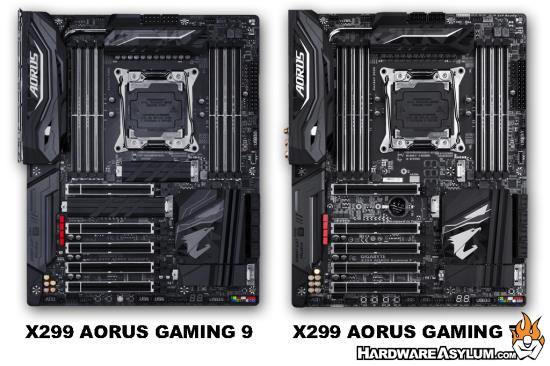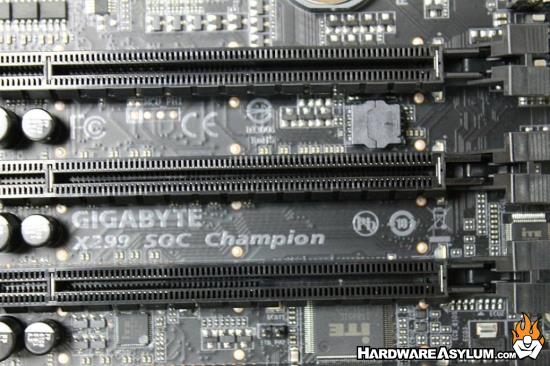X299 Aorus Gaming 9 and X299 Aorus Gaming 7 - First Look!
Gigabyte is one of those companies that LOVES to change their mind and when they do watch out because they will go all in to make their vision happen. Case in point EVERYTHING is going to change and they . Case in point in 2011 Gigabyte decided to taking on the overclocking niche with a full line of overclocking motherboards. Custom colors, custom designs dedicated overclockers any and everything they needed to make it work they did.
Before overclocking motherboards everything was built on blue PCBs and there was a time that color coding was used to help OEMs build PCs. If you step back much of this is creative marketing but instead of addressing the problem they take the opportunity to highlight the situation and their solution best they can.
This year overclocking has fallen by the wayside in favor of a new niche, gaming. The Gigabyte OC Lab is now the Aorus Gaming Lab and while you can still overclock on Aorus motherboards the marketing message has changed to focus on gaming and esports.
During Computex the Intel X299 chipset was announced and Gigabyte (Aorus) launched three new board designs following their Aorus Gaming brand and yet still retaining some of the Ultra Durable nomenclature. I wanted to take a closer look at the X299 Gaming 7 and X299 Gaming 9 motherboards. If history holds true the Gaming 7 will be the high-end mainstream board while Gaming 9 will most likely be limited edition, cost prohibitive and generally unavailable.

Looking at the boards side by side they look virtually identical. In fact the only difference I see is the lack of M.2 covers and a few slight changes to the onboard heatsinks. Looking at the feature list tells a similar story.
Gaming 9: Intel X299 Gaming motherboard with RGB Fusion, Digital LED, Triple M.2 with Thermal Guard, ESS SABRE 9018K2M DAC, Killer DoubleShot™ Pro, Front & rear USB 3.1 Gen 2 Type-C
Gaming 7: Intel X299 Gaming motherboard with RGB Fusion, Digital LED, Triple M.2 with Thermal Guard, ESS SABRE 9018 DAC, Killer DoubleShot™ Pro, Front & rear USB 3.1 Gen 2 Type-C
The only major difference is the DAC processor.
Key Features
- Supports Intel® Core™ X-series Processor Family
- Quad Channel Non-ECC Unbuffered DDR4, 8 DIMMs
- Intel® Optane™ Memory Ready
- ASMedia 3142 USB 3.1 Gen 2 with USB Type-C™ and Type-A
- Front USB 3.1 Gen 2 Header
- 3-Way Graphics Support with Dual Armor and Ultra Durable™ Design
- Ultra Durable™ Base Plate Armor and Integrated I/O Shield Armor Design
- Server-Class Digital Power Design
- 127dB SNR AMP-UP Audio with High-End ESS SABRE 9018K2M DAC, LME 49720 and OPA1622 OP-AMP, WIMA audio capacitor
- Sound BlasterX 720°, the top-of-the-line audio engine solution for 4K gaming and entertainment
- Killer DoubleShot™ Pro and Intel® GbE LAN for the best gaming networking experience possible
- Killer 2x2 802.11ac Wireless – AC 1535
- RGB FUSION with Multi-Zone Digital LED Light Show design, support digital LED & RGB LED strips
- Swappable Overlay for Accent LED
- Smart Fan 5 features Multiple Temperature Sensors and Hybrid Fan Headers with FAN STOP
- Triple Ultra-Fast M.2 with PCIe Gen3 x4 interface and Thermal Guard
- PCIe Gen3 x4 M.2 Add-In Card with Thermal Guard
- NVMe PCIe Gen3 x4 U.2 adaptor
- USB DAC-UP 2 with Adjustable Voltage
- Precise Digital USB Fuse Design for Stronger Protection
- Anti-Sulfur Resistor Design
- Ultra Durable™ 25KV ESD and 15KV Surge LAN Protection
- Lightning-Fast Intel® Thunderbolt™ 3 support by option AIC
- GIGABYTE UEFI DualBIOS™ with Q-Flash Plus USB port
Both motherboards are designed for 3-way graphics support and include a High Bandwidth bridge for SLI. As you can assume Fusion RGB is a standard feature with lighting support everywhere including on the I/O shields, expansion slots, memory slots, heatinks and audio controller.
DDR4 memory support is limited to 2666Mhz and I find it interesting that memory density is dictated by the PCI Express Lane support in your CPU. That makes sense given that the 16-Lane CPUs only have a dual channel memory controller while the 44-Lane and 28-Lane CPUs support quad channel memory like they should.

I doubt anyone will load up a Gaming 7 or Gaming 9 with a 16-Lane CPU but stranger things have happened. Sadly, it would seem the SOC (Super OverClock) versions of the X299 were not released during Computex however I did see some photos of the X299 SOC Champion. So I'll be crossing all of my body parts in anticipation. ![]()
Related Web URL: http://www.gigabyte.us/Motherboard/Socket-2066

